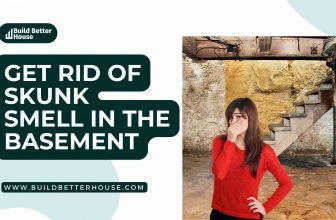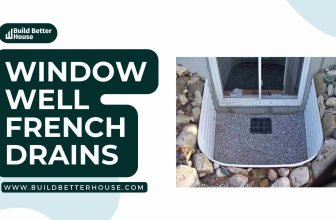10 Best French Drains Alternatives To Drain The Water Easily

A French drain diverts rainwater from a structure to reduce floods and saturated soil erosion. While I may not be able to install one, I have a list of the best French drains alternatives to choose from.
Although the French drain is one of the most popular methods for adding more drainage, there are other viable solutions. Before installing a French drain in your home, consider these options thoroughly.
This article will guide you through everything you need to know about the most effective French drains alternatives to own the best drainage system on your property. Let’s get started.
Comparison Of The Best French Drain Alternatives
MODEL | FEATURES | PRICE | RATING |
Sump Pumps | Mixed (Flat and Sloping) terrain area, Fast drain speed, Metal material, Easy to install | Moderate | 4.8 / 5 |
Valleys or Swales | Sloping terrain area, Slow drain speed, Soil material, Moderate to install | Low | 4.7 / 5 |
Dry Wells | Flat terrain area, Fast drain speed, Stone material, Moderate to install | High | 4.8 / 5 |
Sandbags | Mixed (Flat and Sloping) terrain area, Slow drain speed, Sand material, Easy to install | Low | 4.6 / 5 |
Stairs | Sloping terrain area, Fast drain speed, Concrete material, Moderate to install | Low | 4.7 / 5 |
Bog Gardens | Flat terrain area, Slow drain speed, Soil material, Moderate to install | High | 4.6 / 5 |
Gutters | Structure’s roof terrain area, Fast drain speed, Cast iron material, Easy to install | Low | 4.8 / 5 |
Landscaping | Garden terrain area, Slow drain speed, Geotextile fabric material, Easy to install | Low | 4.6 / 5 |
Terrace | Sloping terrain area, Moderate drain speed, Concrete material, Moderate to install | Low | 4.8 / 5 |
Trench Drain | Mixed (Flat and Sloping) terrain area, Fast drain speed, Concrete material, Moderate to install | Low | 4.7 / 5 |
The 10 Best French Drains Alternatives
I’ve compiled a list of the best French drains alternatives to assist you in choosing the ideal landscaping approach for properly redirecting runoff and preventing wet ground and erosion. Here are the ten best French drains alternatives:
Sump Pumps
Sumps are one of the most popular alternatives to French drains. They extract water from the basement and away from the residence.
Sump pumps are top-rated because they increase drainage but have a few drawbacks. Because they require power, they can be costly to construct and operate.
You might need a sump pump in a high-risk flood zone to remove excess water from the basement, or water overflow and flooding may result.
Valleys or Swales
A valley is often a drainage ditch that forms a natural drainage system around a home. The trench must slope downward to direct the water to the appropriate location. If the trench is shallow, it should be covered with gravel, gutters, or ventilated pipes.
Valleys are an excellent alternative to French drains if you are worried about their performance, as they operate similarly.
A French drain is a channel that leads water away from a specific location. It is a trench with pipes that may be used to drain water away or divert it. A valley is a natural method of allowing water to drain and disperse into a separate area. Gravity and the positioning of the ground are used for increased efficiency.
A suitable location must be available for a valley to form, which may be challenging to achieve. These are excellent French drains alternatives if you want to modify your landscape.
Dry Wells
Dry wells are utilized to move groundwater below the surface. Their level is much deeper than their width near the summit, and they are used to transport fresh water.
A dry well will keep a lot of water in place if you can acquire one. Gravel stone and landscaping fabric surround these wells, which drain water into the surrounding terrain. It’s a beautiful choice if you want to address your water shortage.
A dry well is an excellent option if you don’t want to invest money in a French drain. It will collect rainwater and keep it in an underground storage facility.
A dry well system is great for storing extra water. You cannot go down this route if you do not have enough money. Those who seek cheaper solutions may wish to install stairs.
A dry well can be an excellent way to solve flooding problems in your yard, but it won’t suit everyone. Using dry well systems like this might help eradicate flooding on your property. However, despite being expensive, a dry well process is difficult to ignore because it works well.
Sandbags
Using sandbags to divert excess water in a safe direction (away from your house’s foundation, for example) is a temporary solution. You should not employ this approach permanently, but you can use sandbags as French drains alternatives.
The material that fills a sandbag (or any sandbag alternative) will not get washed away (thanks to the fabric).
A sandbag can be simply a potato sack filled with sand or an inflatable plastic tube filled with air. As long as it can resist water and direct it in the right direction, its appearance doesn’t matter.
Stairs
Regarding drainage, stairways can be advantageous in specific locations of houses with a significant altitude change or slope. These French drains alternatives have a built-in plumbing system that directs water to the appropriate area without a French drainage pipe.
While concrete stairs are solid and efficient for the job, they are unsuitable for every house. To build stairs, you’ll need a significant slope or a lot of land at the bottom of the staircase.
Increasing the number of stairs is an excellent option in place of installing a French drain. The same principle applies here as in the previous example of the valley, but the purpose is to let the water run downhill rather than upwards. Adding stairs to your house will help with drainage as a result. To prevent soil degradation, follow the instructions properly.
Walking down the stairs may be tricky, as some spots will be slippery because water may accumulate before the stairs. The stairs won’t let you slide down at once, which may prevent significant water seeping and huge muddy patches. You may want to avoid substantial water seeping and big puddles by keeping the stairs dry.
Building these stairs will not be difficult, but the result will be worthwhile. In addition to the extra stairs, this method will enable water to flow downhill.
For the water not to enter the house and other places where stagnant water is not desired, you might use these extra stairs to direct it away. You may create a wide range of stairs, so you may be creative and add a unique element to your home.
Bog Gardens
If you have identified a location where water accumulates on your property that is not too much (or even if it is if you enjoy it), you may build a bog garden as an alternative to French drains.
Grass and flowers that increase soil permeability and water drainage are used to manufacture bog gardens. It would help if you choose the correct plants for boggy conditions, which include soggy, overgrown soils and possibly more shade than sunlight.
Creating a new garden area will enhance your yard’s beauty. Adding this to your property can assist with drainage and improve your yard’s beauty. Maintaining the bog garden will make you feel great about your property. It will work well and make you feel good.
The only drawback of these French drains alternatives is that it produces mosquitoes like any swamp.
Gutters
Installing gutters on a structure’s roof is a practical way to increase drainage and basement sealing. You may direct water to a ground drain rather than a central flood zone by installing gutters on almost any structure’s exterior.
Furthermore, there are other methods to prevent standing water and water overflow. Gutters are excellent French drains alternatives. You can also install copper gutters and other drain pipes in the ground to avoid standing water and extra surface drainage.
Landscaping
Incorporating natural landscaping can provide drainage to your home without requiring more drains or perforated pipes while enhancing your property’s appearance and style.
One way to improve drainage in your garden is to include plants with good water absorption qualities, such as vines or flower beds. Another option is to apply mulch as a top layer, enhancing drainage without needing a French drain installation.
Terrace
Terraces are perfect for sloping sites & steep terrain. They are self-draining stairs that prevent water accumulation and soil erosion.
Terraces drain the water more effectively and faster than a French drain. You can even add grasses or trees to stop water accumulation.
Terraces naturally filter water. But it doesn’t work on flat land. It only works on sloping terrain.
Trench Drain

The trench drain fits low to medium-flooded areas and crawl space drains. It drains excess water to the underground storage tank or central wastewater line.
Trench drains consist of a perforated pipe or weeping tile. They move water away from your home and prevent water buildup in paved areas & parking lots.
Trench drains can be easily installed on basement floors, near exterior walls & decks.
Benefits Of French Drains Alternatives
French drains alternatives are affordable and easy to install. This is what separates them from French drains. Here are the benefits of French drain alternatives:
- French drain alternatives do not get blocked by salts and sediments.
- French drain alternatives take little space for installation. It doesn’t disturb any service lines of sewage or groundwater.
- They ensure a simple installation that consists of an adjustable drain tile and catch basin.
- French drain alternatives are operated on battery; you don’t have to worry about electrical cuts.
- French drain alternatives are available at cheaper rates. Plus, they are durable and last for longer periods.
How Does A French Drain Work?

Before learning about the French drains alternatives, let’s understand how a French drain works.
French drains are trenches that contain weeping tile, which is covered with gravel to prevent mud and debris from entering. The pipes divert water away from your home’s downspouts to prevent flooding from excess rainfall.
French drains can also be used to divert water in areas with little to no slope naturally. The weeping pipe or tile in a French drain may become clogged, requiring you to excavate it to correct the problem. If you don’t clear the clog, your yard or basement may flood.
French drains are an excellent option when you have shallow waterlogged areas in your yard or cannot construct a sloped landscape for drainage. Again, there are other, more effective, and practical French drains alternatives to divert runoff depending on your terrain.
Assess your property to establish the most suitable drainage system for your home. You may also find French drains alternatives below.
3 Reasons To Avoid Installing A French Drain
French drains are a helpful way of draining water – but there are a few causes you may not want to install in your backyard and require French drains alternatives. These reasons are:
- They are not as strong as a sump pump
- They need digging and spreading a drain line
- They are not effective if the water requires to be drained uphill
You can use the French drains alternatives mentioned above for draining excess water from the landscape.
Choosing The Best French Drain Alternatives For Different Areas
Here are the best French drain alternatives for different areas:
- Flat terrain – Bob garden, Sump pump, Dry well
- Sloping sites – Terrace, Swales
- Heavily flooded areas – Electric sump pump
- Low-medium flooded areas – Bog garden, Trench drain.
Conclusion: Best French Drains Alternatives

Sometimes, you prefer an alternative approach to draining excess water from the landscape. French drains divert water from one location in the landscape to another to prevent soggy soil and erosion. Homeowners often connect them to downspouts to avoid waterlogged soil around a house’s foundation.
After I’ve described the best French drains alternatives, you can make the right decision. Hopefully, you’ll be able to avoid excessive water volumes inside your home.
FAQs On Best French Drains Alternatives:
1. What can I do instead of a French drain?
Swales, commonly called valleys, can be used as a substitute for French drains to collect and redirect rainwater. These shallow channels don’t require pipes and can be spotted typically along the edges of a property, following the land’s natural slope to channel the water to the nearby wooded areas or ditches.
2. How can I improve drainage without a French drain?
Here are the ways to improve drainage without a French drain:
Aerate the lawn
Construct a rain garden
Add a dry creek bed
Build up low spots
Install a French drain
Create a swale
Clean gutters and add downspouts
3. Which is better: French drain or swale?
Installing French drains is a practical way to enhance your property’s drainage system and safeguard your home from water damage. They are more efficient than swales and can increase the value of your property. If you’re experiencing drainage issues, consider hiring professionals to install drains as a viable solution.






